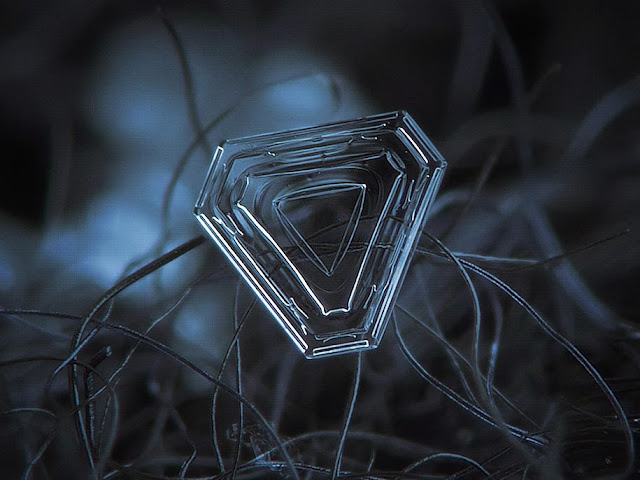Images shared via Alexey Kljatov.
A Russian photographer, Alexey Kljatov created a self made camera-lens combination to take some inexpensive photographs of snowflakes that clearly show the crystallographic structure of each flake.
With each flake having undergone different thermodynamics, no two flakes are alike. What is interesting is that each flake shows the basic most thermodynamic concepts with respect to crystallography at a macro level.
The dendrites grow spaced from each other like leafs on a branch instead of a single solid being frozen because, at the seed's surface and the part yet liquid (solid-liquid interface) at the center, the temperature higher than it is in the solid or liquid due to temperature inversion. This means not only the dendrites tend to equally space away from each other but also grow further away from the interface deep into the liquid depending on the time they get to freeze. This results in the dendrites growing in a pattern of branch and leaf like structure so well, almost as if it was calculated before it was made. Well not almost... it was naturally calculated before it formed. It's thermodynamics in action. During freezing the latent heat of fusion given away by the freezing material is being exchanged at the solid-liquid interface which results in inversion of temperature in this region. The inversion simply denotes the raise in temperature above the freezing point as well as the ambient liquid temperature at the interface. Instead of the inversion of temperature slowing down the process, it instead gives the process a pattern. The material does not wait for this temperature to lower down as it finds a freezing opportunity on as a separate dendrite. Crystal starts forming and growing in shape of dendrites. Depending on what the localized thermodynamic conditions were, each flakes forms in different sizes and shapes, which is remarkably shown in the photography.
A Russian photographer, Alexey Kljatov created a self made camera-lens combination to take some inexpensive photographs of snowflakes that clearly show the crystallographic structure of each flake.
With each flake having undergone different thermodynamics, no two flakes are alike. What is interesting is that each flake shows the basic most thermodynamic concepts with respect to crystallography at a macro level.
The dendrites grow spaced from each other like leafs on a branch instead of a single solid being frozen because, at the seed's surface and the part yet liquid (solid-liquid interface) at the center, the temperature higher than it is in the solid or liquid due to temperature inversion. This means not only the dendrites tend to equally space away from each other but also grow further away from the interface deep into the liquid depending on the time they get to freeze. This results in the dendrites growing in a pattern of branch and leaf like structure so well, almost as if it was calculated before it was made. Well not almost... it was naturally calculated before it formed. It's thermodynamics in action. During freezing the latent heat of fusion given away by the freezing material is being exchanged at the solid-liquid interface which results in inversion of temperature in this region. The inversion simply denotes the raise in temperature above the freezing point as well as the ambient liquid temperature at the interface. Instead of the inversion of temperature slowing down the process, it instead gives the process a pattern. The material does not wait for this temperature to lower down as it finds a freezing opportunity on as a separate dendrite. Crystal starts forming and growing in shape of dendrites. Depending on what the localized thermodynamic conditions were, each flakes forms in different sizes and shapes, which is remarkably shown in the photography.













No comments:
Post a Comment